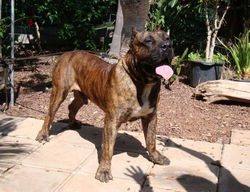top of page

.png)
About
Dogs of Our Lineage
Over eight generations of World, Spanish, and International Champion Presa Canario are found in the lineage of our Conquistador K-9 bloodline. We invite you to learn and explore more about these famous contributors to our Presa Canarios.
All things great about us we owe to the generations before us.
Breeding a litter of pups is not the same as becoming a breeder and developing a bloodline. Many fine dogs have been produced by the former, but to continue to develop and refine the finest characteristics of the breed into a family of dogs that breed true for these characteristics is the definition of a ‘bloodline’ and the ultimate goal of a ‘breeder’ . We have within our breed bloodlines that are known for producing great dogs. All quality bloodlines have been established by incorporating quality brood stock from someone else’s bloodline.
We take the time here to pay homage to the great dogs and breeders that have come before us and to share the reality of our breeding program and the clear connection between these remarkable generations of the past and our productions of today.
 |  |  |  |  |
|---|---|---|---|---|
 |  |  |  |  |
Conquistador K-9 Bloodline Development
Becoming a breeder and developing a ‘bloodline’ demands that you establish a breeding plan. Number one is to identify those breed characteristics that you want to see reproduced in the dogs that you will produce. Identifying your individual list of characteristics that you want to develop in your bloodline requires that you are familiar with the breed character and are knowledgeable about the breed standard that have been established by the experts within the breed.
One of the most ground-breaking things we do in our bloodline development and pedigree analysis is look for related traits. Searching for related traits isn’t a new idea. Literature indicates that as far back as the fourth century BC, people were looking for something physical, like tail carriage or ear length, to predict something intangible — courage or sagacity, for example. The Greek philosopher Xenophon, describing the interests and values of sporting men, said that tan-colored dogs with black muzzles were esteemed as the best hunters.
New genetic research indicates that yesteryear’s cynologists were on the right trail, but barking up the wrong trees. Dog breeds are not mix-and match combinations of thousands of small parts; rather, they are more like combinations of genes prepackaged in bundles and shuffled around. Of the thousands of genes in the genome (dogs have about 19,000, compared to humans’ approximately 23,000), an inordinate number are involved in communicating with one another, sending information that either activates or represses a “dimmer switch” in other genes. This molecular maneuvering isn’t readily visible in most mammals.
Pedigree analysis will also reveal the style of breeding that produced the specimen. Why would this be important? Certain styles of breeding, namely inbreeding and linebreeding tend to fix and preserve desirable traits by increasing homozygosity of the genes. This means that the gene pairs are the same. Since the gene pairs are the same, the genes for their quality will be passed to the dog’s offspring 100% of the time. Outcross breeding increases heterozygosity of the genes. This is where the gene pairs are not the same. Dogs that are the product of an outcross breeding will pass the genes for their quality traits to their offspring only 50% of the time because most of the time their genetic makeup is heterozygous. The value of a stud dog or brood bitch lies in the dog’s ability to consistently and predictably pass specific traits to their offspring. You will find many common threads in our bloodline that reflect our carefully planned breeding program.
DOGS OF OUR LINEAGE
All these famous Presa Canario below are found in our dog's pedigrees.

bottom of page























